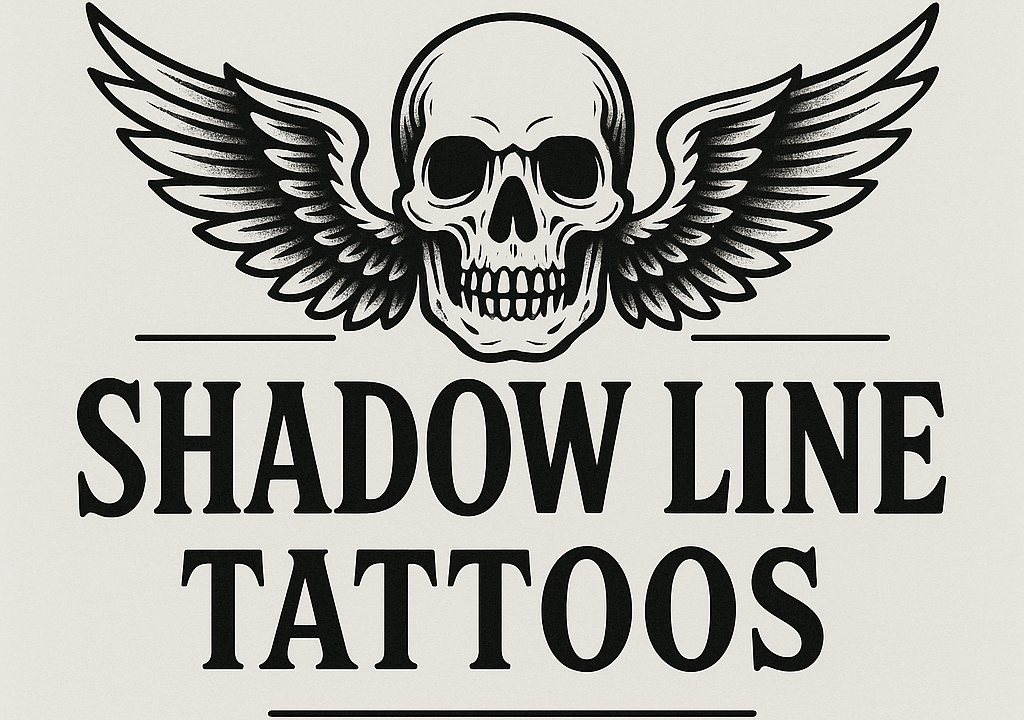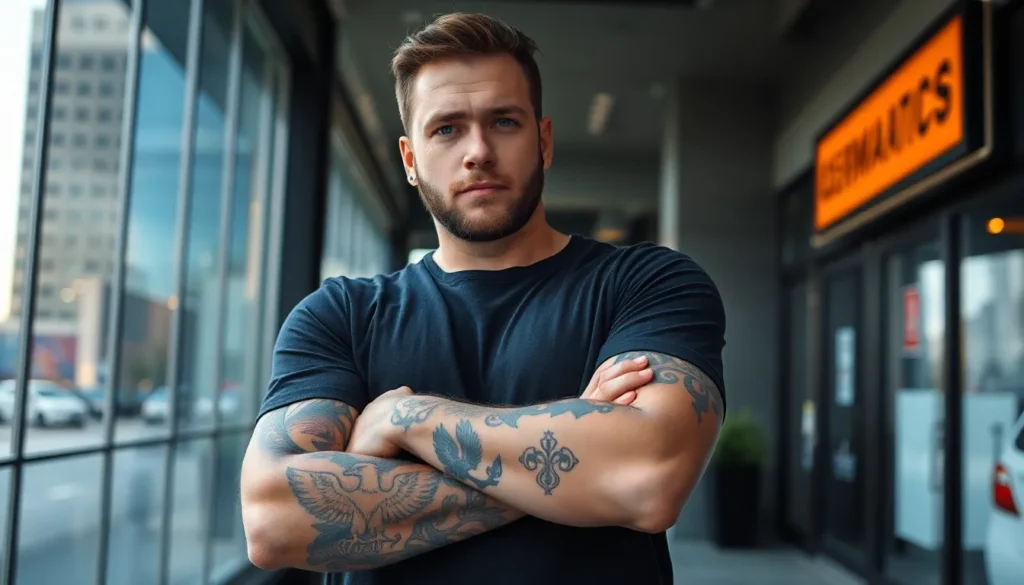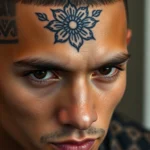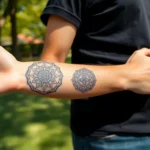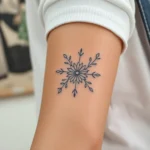German tattoo designs offer a rich tapestry of cultural symbolism that’s captivated ink enthusiasts worldwide. From powerful Germanic symbols to intricate traditional motifs, these tattoos tell stories of heritage, strength, and timeless artistry that resonate across generations.
We’ve discovered that German-inspired tattoos aren’t just about bold imagery – they’re deeply rooted in centuries of folklore, mythology, and cultural significance. Whether you’re drawn to the majestic German eagle, ancient runic scripts, or the iconic Bavarian coat of arms, these designs carry profound meaning that goes far beyond their striking visual appeal.
Today’s tattoo artists have masterfully adapted traditional German elements into contemporary designs that honor the past while embracing modern aesthetics. We’ll explore the most compelling German tattoo concepts that blend historical authenticity with artistic innovation, helping you find the perfect design that speaks to your personal connection with German culture and heritage.
Traditional German Symbol Tattoo Designs
Building on Germany’s rich cultural tapestry, traditional symbols offer powerful tattoo designs that connect wearers to centuries of heritage and meaning.
Eagle and Coat of Arms Variations
German federal eagles represent the most iconic tattoo choice for those seeking official heraldic symbolism. We see these majestic birds typically rendered with spread wings and detailed feather work, often incorporating the traditional black and gold color scheme. Modern interpretations include stylized versions that blend realistic shading with geometric elements.
Regional coat of arms designs provide deeply personal connections to exact German states and cities. Bavaria’s blue and white diamond pattern creates striking sleeve compositions, while Prussia’s black eagle offers bold chest piece opportunities. These heraldic symbols work exceptionally well when combined with banner elements displaying family names or meaningful dates.
Imperial eagle variations from different historical periods allow for unique customization options. The Holy Roman Empire’s double-headed eagle makes for powerful back pieces, while the simpler single-headed versions suit smaller placements on arms or shoulders. Each design can incorporate personal elements like family crests or important German locations.
Germanic Runes and Ancient Scripts
Elder Futhark runes serve as the foundation for meaningful Germanic script tattoos. We recommend researching authentic runic alphabets rather than modern interpretations to ensure historical accuracy. Popular choices include “Algiz” for protection, “Fehu” for prosperity, and “Tiwaz” for courage and victory.
Runic binding combinations create powerful protective symbols when multiple runes merge into single designs. These bind-runes traditionally combined two or more runic symbols to amplify their meanings. Contemporary tattoo artists often incorporate these ancient practices into modern compositions that flow naturally with body contours.
Gothic script lettering brings medieval German manuscripts to life through tattoo artistry. This ornate writing style works beautifully for German phrases, family mottos, or important words. The intricate letterforms require skilled artists who understand proper Gothic proportions and authentic medieval penmanship techniques.
Medieval Castle and Architecture Motifs
Neuschwanstein Castle inspired designs capture Bavaria’s fairy tale architecture in detailed tattoo form. We often see these romantic castle silhouettes incorporated into industry compositions featuring Alpine backgrounds. The castle’s distinctive towers and dramatic positioning make it ideal for forearm or calf placements.
Rhine Valley fortress clusters offer multiple castle options within single tattoo compositions. These medieval strongholds create dramatic skyline effects when arranged along curved body areas like ribs or shoulders. Each fortress tells its own historical story while contributing to an overall German heritage narrative.
Gothic cathedral elements bring sacred German architecture into tattoo artistry through detailed stonework and soaring spires. Cologne Cathedral’s twin towers provide iconic reference points, while intricate rose window designs create beautiful circular tattoo options. These architectural elements often incorporate religious symbolism alongside cultural heritage themes.
German Cultural Heritage Tattoo Concepts
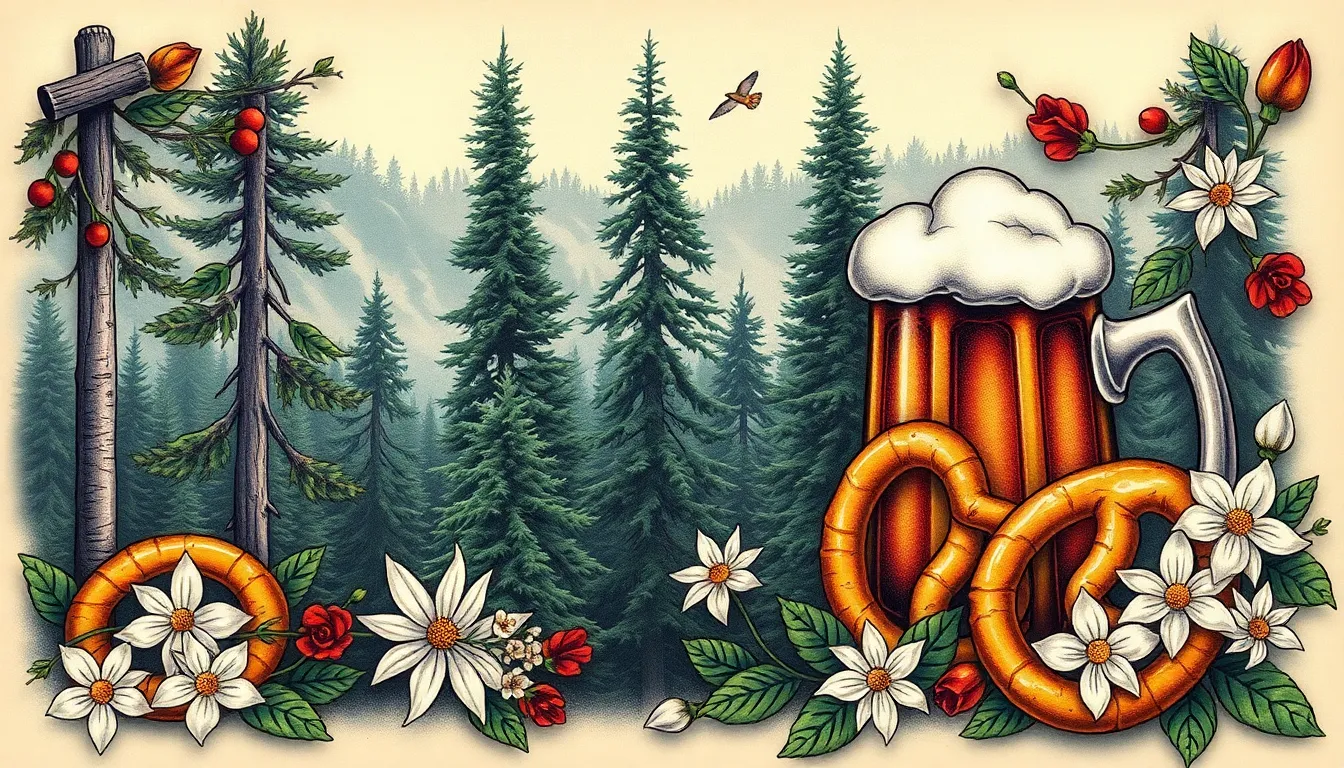
These heritage inspired designs capture the essence of Germany’s vibrant traditions and cultural celebrations. We’ll explore some of the most popular cultural elements that translate beautifully into meaningful tattoo art.
Oktoberfest and Beer Culture Imagery
Beer steins and traditional mugs represent the heart of German festive culture and community gathering traditions. We often see these designs paired with hop leaves and barley grains to showcase the craftsmanship behind Germany’s legendary brewing heritage. Bavarian hats and dirndls add authentic cultural flair to these tattoos while celebrating traditional German attire.
Pretzels and sausages frequently appear alongside beer imagery to create comprehensive Oktoberfest themed pieces. Artists incorporate golden wheat stalks and brewing equipment like copper kettles to emphasize the artisanal nature of German beer making. These designs work exceptionally well as sleeve tattoos or larger back pieces where multiple elements can tell a complete cultural story.
Black Forest and Nature Inspired Designs
Oak leaves symbolize strength and endurance while connecting wearers to Germany’s ancient forest traditions. We recommend incorporating towering pine trees and dense forest scenes that capture the mystical beauty of the Schwarzwald region. Wildlife elements like eagles and deer add natural symbolism representing resilience and harmony with nature.
Mountain landscapes featuring the Alps create dramatic backdrops for nature themed German tattoos. Fairy tale cottage designs inspired by Brothers Grimm stories blend seamlessly with forest imagery. These tattoos often feature intricate shading techniques that bring the depth and mystery of German woodlands to life on skin.
Folk Art and Traditional Patterns
Edelweiss flowers symbolize bravery, love, and purity making them perfect centerpieces for German heritage tattoos. We see intricate floral motifs incorporating roses, forget me nots, and other native German flowers that reflect the country’s rich botanical heritage. Bavarian patterns featuring hearts, stars, and geometric designs mirror traditional textile and pottery decorations.
Traditional German folk art colors of deep reds, forest greens, and golden yellows create authentic looking tattoos that honor historical craftsmanship. Wooden cuckoo clocks and traditional Alpine houses add whimsical elements that celebrate Germany’s artisanal traditions. These patterns work beautifully as accent pieces or can be expanded into larger compositions that tell stories of German cultural identity.
German Language Typography Tattoos
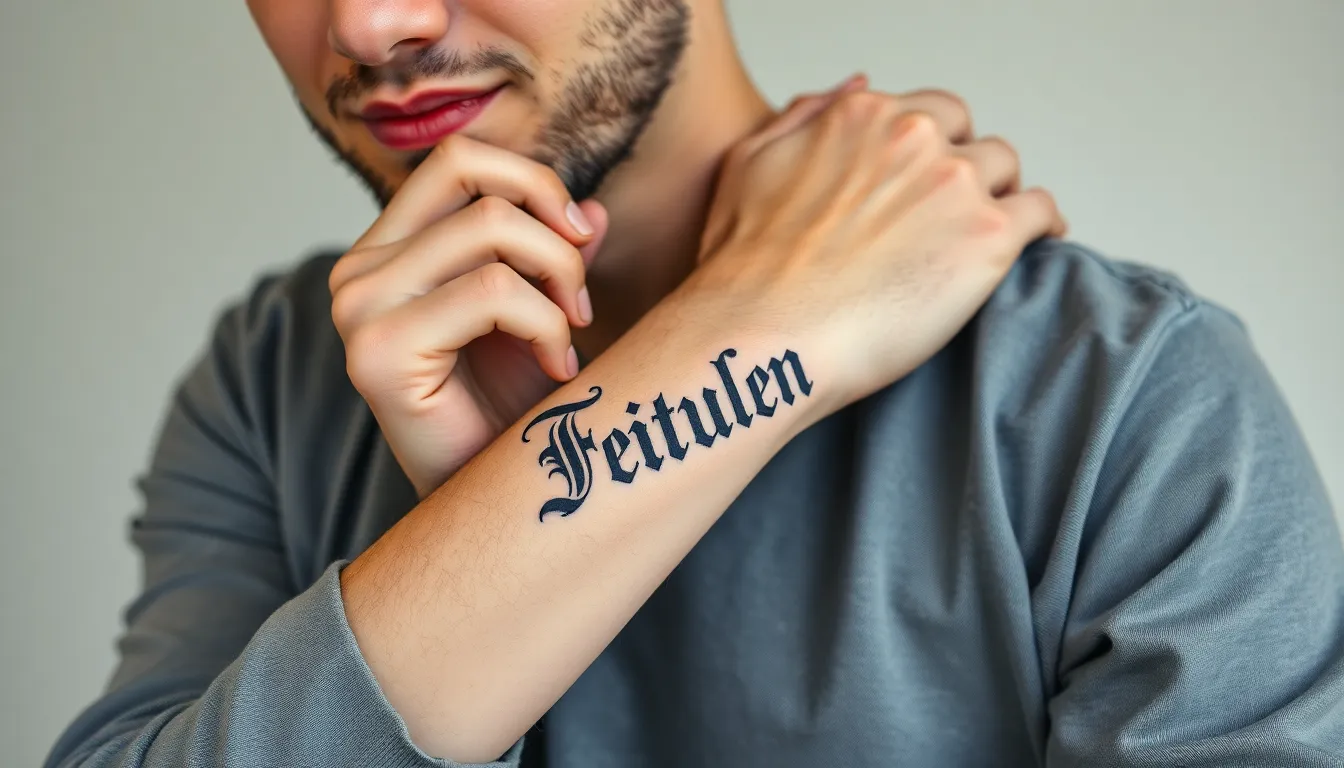
Typography tattoos offer an elegant way to incorporate the German language into your body art while celebrating the country’s rich literary and cultural traditions. These text-based designs allow you to express personal beliefs, commemorate loved ones, or showcase your connection to German heritage through carefully chosen words and phrases.
Meaningful German Quotes and Phrases
Inspirational German quotes create powerful tattoo statements that carry deep personal significance. Phrases like “Leben ist ein Abenteuer” (Life is an adventure) and “Morgen ist ein neuer Tag” (Tomorrow is a new day) provide daily motivation while showcasing your appreciation for German philosophy. These uplifting messages work exceptionally well for placement on the forearm, ribcage, or shoulder blade.
Cultural German phrases reflecting national values make equally compelling tattoo choices. Words such as “Freiheit” (freedom) and “Einigkeit” (unity) evoke Germany’s historical struggles and triumphs while connecting you to the country’s core principles. Shorter phrases offer versatility in placement, working beautifully on the wrist, behind the ear, or along the collarbone.
Literary German excerpts from famous authors like Goethe, Schiller, or Heine add intellectual depth to your tattoo design. Consider selecting meaningful lines from beloved German poetry or prose that resonate with your personal journey or values.
Gothic and Blackletter Font Styles
Gothic fonts provide the perfect foundation for German language tattoos due to their historical connection to medieval Germany. These intricate letterforms feature bold strokes, ornate flourishes, and dramatic angles that create visually striking tattoo designs. Blackletter fonts specifically evoke the manuscript traditions of German monasteries and universities, adding authentic cultural weight to your chosen text.
Traditional blackletter variations include Fraktur, Textura, and Schwabacher styles, each offering distinct characteristics for your German typography tattoo. Fraktur presents the most recognizable German blackletter style with its characteristic broken letterforms, while Textura provides a more formal, ecclesiastical appearance perfect for religious or philosophical phrases.
Modern Gothic interpretations allow tattoo artists to adapt these historical fonts for contemporary skin art. Artists can adjust letter spacing, add decorative elements, or modify certain characters to ensure optimal readability and aesthetic appeal when translated to tattoo form.
Personal Names in German Script
Family names in German script create deeply personal tattoos that honor your heritage or loved ones. Using Gothic or blackletter fonts transforms ordinary names into artistic statements that reflect your connection to German culture. These designs work particularly well when combined with birth dates, memorial years, or meaningful symbols.
Children’s names rendered in traditional German typography make beautiful tribute tattoos for parents wanting to celebrate their family bonds. Consider incorporating decorative elements like small flourishes, stars, or hearts to enhance the overall design while maintaining the script’s elegant appearance.
Ancestral names written in authentic German handwriting styles connect you directly to your family history. Research historical German scripts like Kurrent or Sütterlin for truly authentic representations, though these may require skilled tattoo artists familiar with these specialized writing systems to ensure proper execution and readability.
Historical German Tattoo Inspirations
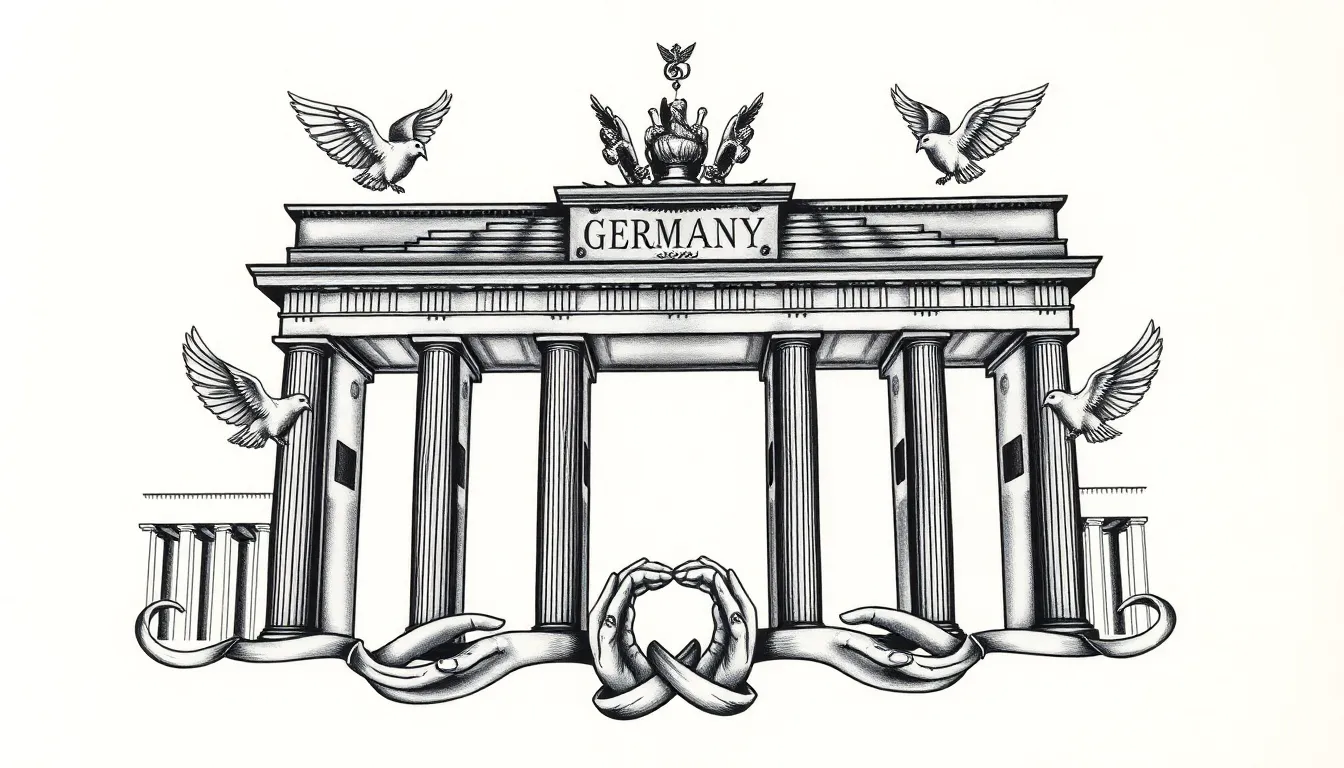
Germany’s complex historical narrative provides profound inspiration for tattoo designs that honor important periods and pivotal moments. These historical tattoos connect us to important chapters of German heritage through meaningful symbols and commemorative imagery.
Industry War Memorial and Remembrance Pieces
Memorial tattoos serve as powerful tributes to those who sacrificed during wartime periods. Crosses and ribbons create the foundation for these remembrance designs, offering respectful ways to honor historical events and fallen soldiers. Historical military emblems provide authentic details that connect wearers to exact regiments or battles.
Patriotic motifs from Industry War periods include eagles, laurel wreaths, and Iron Cross variations that emphasize bravery and honor. Dates and coordinates can personalize these memorial pieces, marking important battles or locations that hold family meaning. Remembrance tattoos often incorporate poppy flowers or forget-me-nots, traditional symbols of memory and loss.
Design elements frequently feature vintage typography with names, ranks, or meaningful phrases in German script. Memorial flames or eternal torches represent the continuing memory of those who served. Artists often blend these elements with personal family military history to create deeply meaningful commemorative pieces.
Berlin Wall and Unity Symbols
Berlin Wall themed tattoos capture one of Germany’s most important historical transformations. Broken chains symbolize the breaking free from division and oppression that defined the Cold War era. Interlocking hands represent the reunion of families and the healing of a divided nation.
Unity symbols include doves carrying olive branches, hearts split and rejoined, or bridges connecting separated landscapes. Wall fragments with graffiti art recreate the authentic aesthetic of the actual Berlin Wall. Calendar dates like November 9, 1989 commemorate the exact moment when the wall fell.
Maps showing divided and reunified Berlin provide geographical context to these historical tattoos. Barbed wire transforming into flowering vines illustrates the transition from division to growth. Checkpoint Charlie imagery and guard tower silhouettes reference exact historical locations that defined the Cold War period.
Famous German Landmarks and Monuments
The Brandenburg Gate stands as Germany’s most iconic tattoo symbol, representing peace and reunification after decades of division. This neoclassical monument’s distinctive columns and quadriga sculpture create instantly recognizable designs that celebrate German unity. Architectural details like the gate’s Doric columns or the goddess of victory provide artistic focal points.
Bavarian flags and Edelweiss flowers represent regional pride and cultural heritage exact to southern Germany. These symbols connect wearers to Bavaria’s distinct traditions and Alpine beauty. Castle designs featuring Neuschwanstein or Hohenzollern create fairy tale inspired tattoos that celebrate Germany’s romantic architecture.
Cologne Cathedral’s Gothic spires and Rhine River scenes combine religious and natural German imagery. Black Forest landscapes with traditional half-timbered houses showcase Germany’s rural beauty and architectural heritage. Lighthouse designs from Germany’s northern coastline represent guidance and strength through historical storms.
Monument tattoos can incorporate Norse mythology figures like Odin and Thor, connecting to broader Germanic cultural heritage that predates modern Germany. German folklore and fairytales from the Brothers Grimm provide whimsical elements that balance serious historical themes with cultural storytelling traditions.
German Automotive and Engineering Tattoos
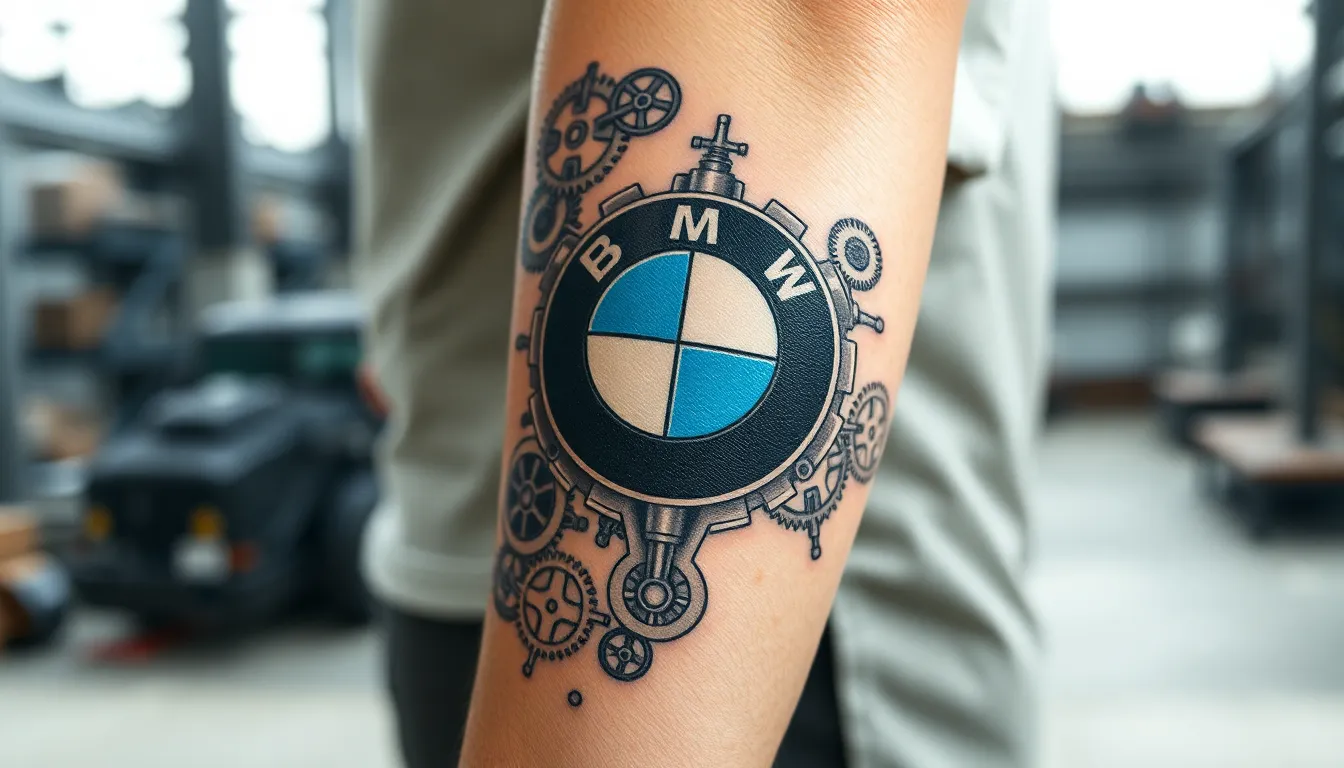
Germany’s reputation for precision engineering and automotive excellence translates beautifully into tattoo artistry. We’ll explore how German car brands and industrial heritage create compelling body art that celebrates mechanical mastery.
Classic German Car Logos and Designs
BMW tattoos dominate the German automotive tattoo scene with their iconic blue and white rotating quadrants symbolizing aircraft propellers. The logo pays homage to BMW’s aviation roots while representing the Free State of Bavaria’s flag heritage. Many enthusiasts combine the BMW emblem with racing motifs, detailed car models, or mechanical elements like gears and roadscapes.
Porsche emblems offer another powerful design choice for automotive tattoo enthusiasts. These tattoos represent luxury, speed, and engineering excellence through various artistic interpretations. Artists create everything from photorealistic Porsche models to abstract geometric versions of the famous emblem, allowing for personalized expressions of automotive passion.
Mercedes-Benz three-pointed stars frequently appear in automotive tattoo collections. The symbol represents the brand’s original vision of universal motorization on land, sea, and air. These designs often incorporate sleek lines and modern aesthetics that reflect the brand’s contemporary luxury appeal.
Precision Engineering and Mechanical Elements
Mechanical gears serve as foundational elements in German engineering tattoos. We see intricate gear systems, clockwork mechanisms, and engine components that highlight the precision craftsmanship associated with German automotive brands. These detailed designs showcase the inner workings of German engineering excellence.
Engine block representations create stunning focal points for automotive enthusiasts. Artists render detailed V8 engines, turbochargers, and transmission systems with remarkable precision. These tattoos celebrate the technical mastery behind German automotive performance.
Blueprint style designs offer a unique approach to engineering tattoos. Technical drawings, schematic layouts, and architectural plans create sophisticated body art that appeals to engineering professionals and automotive enthusiasts alike.
Industrial Revolution Tribute Pieces
Historical machinery motifs pay homage to Germany’s industrial heritage. Vintage manufacturing equipment, steam engines, and early automotive prototypes create compelling narrative pieces. These designs connect modern German engineering achievements to their industrial revolution foundations.
Steel and iron work representations celebrate Germany’s metallurgical expertise. Forges, anvils, and metalworking tools appear in tribute tattoos that honor the craftsmanship traditions behind German engineering excellence. These designs often incorporate flames, hammers, and industrial landscapes.
Factory and manufacturing facility silhouettes create powerful background elements. Smokestacks, assembly lines, and industrial architecture provide context for German engineering tattoos. These elements emphasize the nation’s manufacturing prowess and industrial innovation throughout history.
German Music and Arts Tattoo Ideas
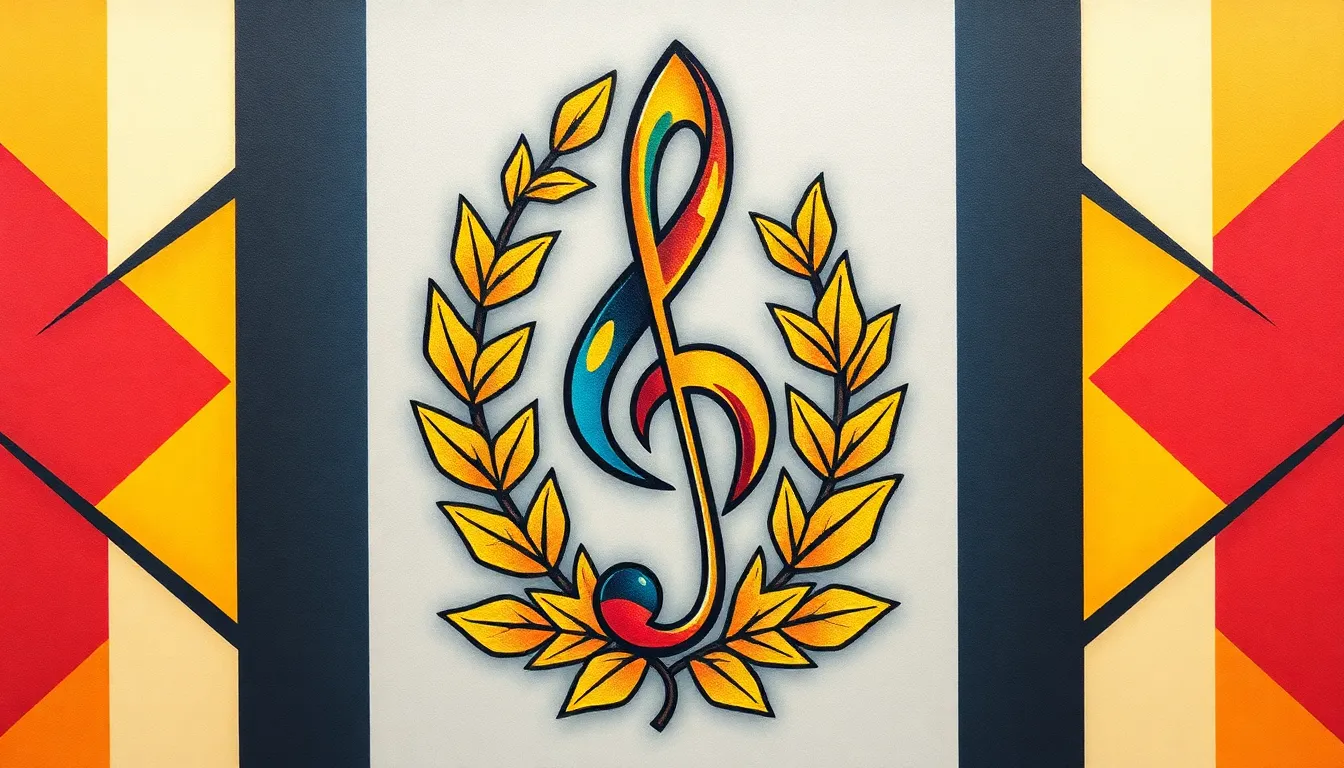
Germany’s artistic legacy offers countless opportunities for meaningful tattoos that celebrate the nation’s profound contributions to music and visual arts.
Classical Composer Tributes and Musical Notes
Portraits capture the essence of legendary composers like Bach, Beethoven, and Brahms in stunning detail. These classical composer tributes work beautifully as sleeve pieces or chest tattoos where artists can showcase intricate facial features and period-appropriate styling.
Musical note fragments from famous compositions create elegant designs that music lovers instantly recognize. We’ve seen beautiful tattoos featuring the opening bars from Beethoven’s Symphony No. 9 or Bach’s Brandenburg Concertos, often rendered in flowing script across the forearm or shoulder blade.
Treble clef symbols represent Germany’s rich musical heritage in a simple yet powerful way. Artists frequently combine these symbols with other German elements like oak leaves or national colors to create comprehensive cultural tributes.
Instrument silhouettes honor exact musical traditions through designs featuring pianos, violins, or organs. These work particularly well when integrated with portraits of composers or musical notation from their masterpieces.
Bauhaus Movement and Modern Art Styles
Bauhaus emblems symbolize the perfect blend of art, create, and technology that defined this revolutionary movement. The iconic Bauhaus logo translates beautifully into tattoo form, especially when rendered in bold black lines with geometric precision.
Geometric patterns inspired by Bauhaus principles create striking modern tattoos featuring clean lines and abstract shapes. These designs often incorporate primary colors or remain in stark black and white to maintain the movement’s aesthetic philosophy.
Abstract expressionism elements reflect artists like Wassily Kandinsky through flowing shapes and vibrant color combinations. We often see these designs wrapped around arms or legs where the natural curves of the body enhance the artistic flow.
László Moholy-Nagy inspired designs feature photographic and constructivist elements that celebrate experimental art forms. These tattoos frequently include overlapping shapes, typography, and light-play effects that showcase the artist’s innovative vision.
German Literature and Poetry Inspirations
Literary quotes from Goethe and Schiller provide profound philosophical statements that resonate deeply with literature enthusiasts. Popular choices include passages from “Faust” or “The Robbers,” often presented in elegant scroll or ribbon designs.
Poetry symbols featuring birds and flowers carry deep meanings rooted in German literary tradition. Nightingales, ravens, roses, and forget-me-nots appear frequently in German poetry and translate into beautiful tattoo motifs with rich symbolic significance.
Classic literature motifs incorporate elements from famous German works like the Lorelei, Siegfried, or scenes from the Brothers Grimm fairy tales. These narrative tattoos often tell complete stories through detailed imagery and symbolic representation.
German script typography elevates literary quotes by presenting them in authentic fonts that connect to the country’s printing and calligraphy traditions. Gothic lettering and Fraktur fonts add historical authenticity to meaningful passages from beloved German authors.
Regional German State Tattoo Designs
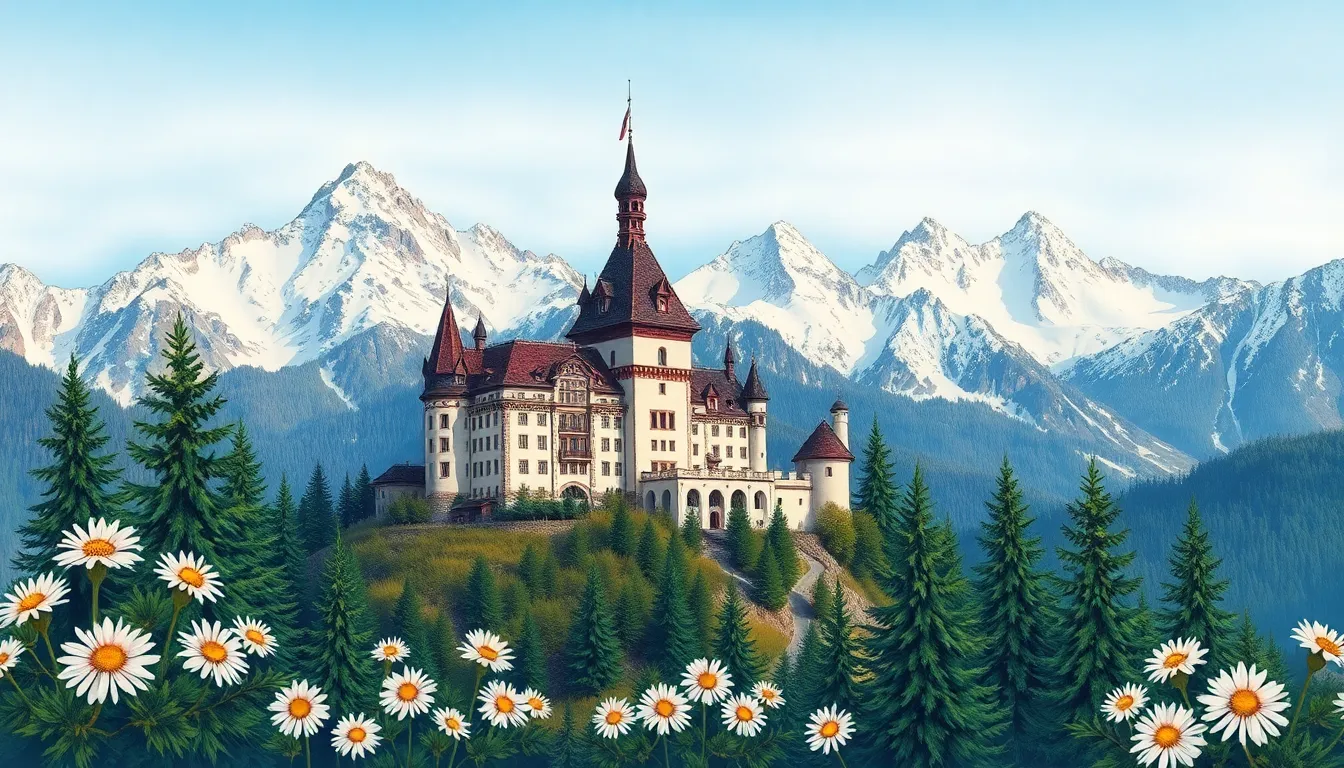
Germany’s diverse regions offer distinct cultural landscapes that translate beautifully into personalized tattoo artwork. We’ll explore how each area’s unique geography and traditions create meaningful body art opportunities.
Bavarian Alps and Mountain Landscapes
Bavarian Alps tattoos capture the majestic beauty of Germany’s southern mountain ranges through detailed scenic compositions. Artists often incorporate Neuschwanstein Castle perched among snow-capped peaks, creating dramatic silhouettes that celebrate Bavaria’s fairy-tale architecture. The Zugspitze, Germany’s highest peak, provides another iconic focal point for mountain industry designs.
Traditional alpine elements enhance these compositions with authentic cultural touches. Edelweiss flowers bloom delicately across forearms and shoulders, symbolizing courage and devotion in Bavarian folklore. Pine trees frame mountain vistas while traditional wooden chalets dot the industry, creating comprehensive regional narratives.
Bavarian village scenes showcase the region’s distinctive architecture through half-timbered houses and church spires. These designs often feature rolling green hills dotted with grazing cattle, windmills, and cobblestone pathways that wind through pastoral settings. Color palettes typically emphasize earth tones, forest greens, and alpine blues that reflect the natural beauty of Southern Germany.
Rhine Valley and River Themes
Rhine River tattoos flow gracefully along arms and torso, depicting Germany’s most historically important waterway. Castle ruins perch dramatically on hillsides above winding river bends, while medieval towers and fortifications tell stories of centuries past. Artists incorporate vineyards cascading down steep slopes, celebrating the region’s industry-renowned wine culture.
Vineyard motifs weave through these designs with grape clusters, twisted vines, and wine barrels that honor Rhine Valley traditions. Gothic cathedral spires pierce skylines above river towns, while traditional wine festivals come alive through detailed market scenes. The Lorelei rock provides mythological elements, often depicted with siren figures or musical notes flowing through the composition.
River navigation elements include historic riverboats, modern barges, and ancient ferry crossings that showcase the Rhine’s role as Europe’s busiest waterway. Bridge designs span across tattoo compositions, connecting different elements while symbolizing the cultural bridges between nations along the river’s path.
Northern German Maritime and Coastal Elements
Maritime symbols celebrate Northern Germany’s deep connection to the sea through lighthouse beacons, sailing vessels, and anchor motifs. Hamburg’s distinctive harbor cranes create industrial silhouettes against stormy skies, while traditional fishing boats navigate rough North Sea waters. Seagulls wheel overhead, adding movement and life to coastal compositions.
Hanseatic League tributes honor the region’s merchant trading history through medieval ship designs, guild symbols, and port city skylines. Lübeck’s seven spires rise majestically from tattoo backgrounds, while Bremen’s town musicians add folkloric elements to maritime themes. These designs often incorporate nautical maps, compass roses, and trade route illustrations.
Coastal industry features capture the rugged beauty of Germany’s northern shores through sand dunes, beach grass, and dramatic cliff formations. Wadden Sea mudflats provide unique textural elements, while traditional North Sea fishing nets create intricate pattern work. Storm clouds and crashing waves add dramatic energy to these powerful regional expressions.
Modern German Pop Culture Tattoos
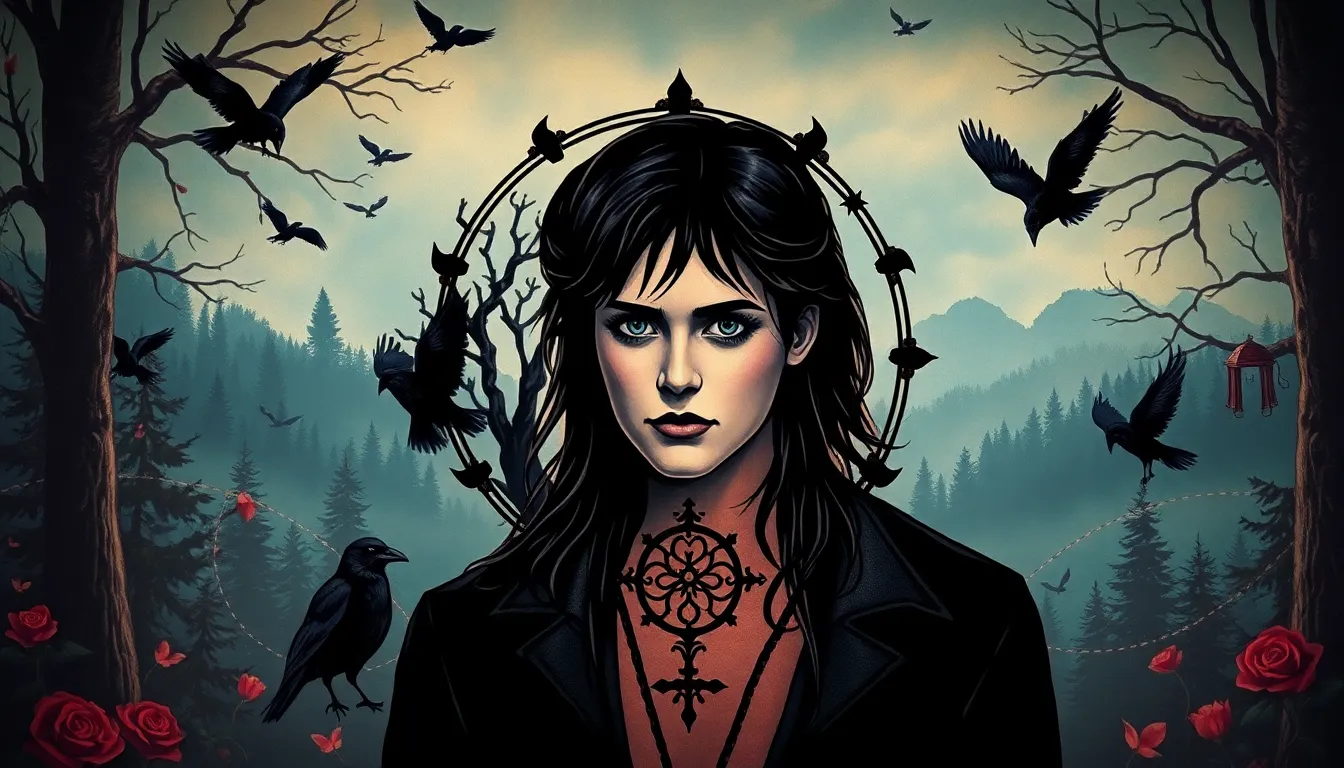
Contemporary German culture offers exciting new avenues for tattoo enthusiasts seeking designs that celebrate the nation’s modern artistic achievements. We’ve noticed growing interest in tattoos that blend traditional German heritage with today’s cultural phenomena.
Contemporary German Film and Television References
Dark series tattoos capture the mystique of Germany’s internationally acclaimed Netflix thriller through symbolic time travel motifs and interconnected family trees. Characters from this cult favorite often inspire minimalist portrait work or abstract representations of the show’s complex timeline concepts.
Good Bye Lenin! inspired designs commemorate this beloved German film through iconic imagery like the falling Lenin statue or vintage East German symbols. We’ve seen artists incorporate these elements into larger pieces that tell personal stories about German reunification.
Black Forest mystique tattoos draw from Germany’s rich storytelling tradition, featuring enchanted woodland scenes with ravens, twisted branches, and fairy tale elements. These designs often incorporate subtle references to the Grimm Brothers’ tales while maintaining a contemporary artistic approach.
German cinema homage pieces celebrate directors like Werner Herzog or Wim Wenders through abstract representations of their most famous scenes or quotes from their films rendered in elegant German script.
Soccer Team Logos and Football Culture
Bayern Munich tattoos dominate German football inspired body art, featuring the club’s distinctive red logo, championship years, or stylized versions of the Allianz Arena. Fans often incorporate player numbers or memorable match dates into these designs.
Borussia Dortmund ink showcases the famous yellow and black color scheme through everything from simple logo reproductions to elaborate stadium landscapes featuring the Signal Iduna Park. We’ve observed particular popularity in tattoos commemorating the team’s Champions League victories.
German national team tributes celebrate Industry Cup victories through creative interpretations of the four championship stars, often combined with the German eagle or rendered in the national colors of black, red, and gold.
Football culture symbols include traditional elements like scarves, stadium architecture, and crowd scenes that capture the passionate atmosphere of German football matches. Player silhouettes of legends like Franz Beckenbauer or modern stars create powerful tribute pieces.
Modern German Fashion and Design Trends
Adidas three stripes tattoos represent one of Germany’s most recognizable global brands through minimalist line work or incorporated into larger athletic themed designs. We’ve seen creative interpretations that blend the logo with personal fitness achievements or sports memories.
Hugo Boss inspired pieces draw from the brand’s clean aesthetic through geometric patterns and sophisticated typography that reflects modern German fashion sensibilities. These designs often feature sleek lines and monochromatic color schemes.
BMW and Mercedes Benz logos translate automotive excellence into body art through everything from simple brand reproductions to complex mechanical interpretations featuring the companies’ engineering innovations. Luxury car enthusiasts often combine these with racing motifs or technical drawings.
Bauhaus design principles influence contemporary German tattoo art through geometric shapes, clean typography, and functional aesthetic approaches that emphasize form following function in tattoo composition.
Conclusion
German tattoo designs offer an incredible journey through centuries of rich cultural heritage and modern innovation. We’ve explored how these meaningful symbols connect us to Germany’s fascinating history while celebrating its contemporary achievements.
Whether you’re drawn to traditional eagles and runic scripts or prefer modern automotive emblems and pop culture references there’s a German-inspired design that speaks to your personal story. These tattoos represent more than just body art—they’re powerful expressions of cultural appreciation and personal identity.
The beauty of German tattoo artistry lies in its versatility and depth. From medieval castles to Bauhaus design principles each element carries profound meaning that resonates across generations making these designs perfect for anyone seeking tattoos with genuine cultural significance.
Frequently Asked Questions
What makes German tattoo designs culturally significant?
German tattoo designs are deeply rooted in centuries of folklore, mythology, and cultural heritage. They feature traditional symbols like the German eagle, runic scripts, and Bavarian coat of arms that connect wearers to authentic historical narratives. These designs blend traditional motifs with modern artistic innovation, creating meaningful body art that celebrates Germany’s rich cultural tapestry.
What are the most popular traditional German tattoo symbols?
Popular traditional symbols include the German federal eagle, regional coat of arms, Germanic runes, and medieval castle motifs like Neuschwanstein Castle. These designs offer personal connections to specific German states and cities while incorporating authentic historical elements that have been passed down through generations.
How can I incorporate German language into my tattoo design?
German language typography tattoos can include meaningful quotes, phrases, family names, or ancestral names rendered in authentic German script. Gothic and Blackletter font styles connect to Germany’s medieval history, while personal German phrases add emotional resonance and celebrate the country’s rich literary traditions.
What German cultural celebrations work well as tattoo themes?
Oktoberfest imagery is extremely popular, featuring beer steins, traditional lederhosen and dirndl attire, pretzels, and sausages. These elements create comprehensive cultural narratives that celebrate Germany’s vibrant traditions and festive spirit, making them ideal for heritage-inspired tattoo concepts.
Are there nature-inspired German tattoo options?
Yes, Black Forest-inspired designs are very popular, incorporating oak leaves, native wildlife, and mountain landscapes. Folk art motifs like edelweiss flowers and traditional Bavarian patterns reflect Germany’s rich botanical heritage and natural beauty, creating stunning nature-themed tattoo designs.
What historical German events make meaningful tattoo subjects?
Berlin Wall-themed tattoos symbolizing unity and freedom are popular, featuring broken chains and interlocking hands. Memorial tattoos honoring wartime sacrifices often include crosses, ribbons, and military emblems. These designs connect wearers to significant historical periods and events.
Can German automotive culture be incorporated into tattoos?
Absolutely! German car logos like BMW, Porsche, and Mercedes-Benz are popular choices. These designs often incorporate racing motifs, mechanical elements like gears and engine blocks, and blueprint-style designs that celebrate Germany’s reputation for precision engineering and automotive excellence.
What modern German pop culture elements work for tattoos?
Modern designs can include references to popular German films like “Dark” and “Good Bye Lenin!”, German football team logos like Bayern Munich and Borussia Dortmund, and iconic fashion brands like Adidas. Bauhaus design principles also inspire contemporary German-themed tattoos.
How do I choose authentic Germanic runes for my tattoo?
Research authentic runic alphabets like Elder Futhark or Younger Futhark to ensure historical accuracy. Each rune carries specific meanings and symbolism. Consult with knowledgeable tattoo artists who understand Germanic scripts to create meaningful designs that respect the cultural significance of these ancient symbols.
What German landmarks make striking tattoo designs?
Brandenburg Gate is a prominent symbol of peace and reunification. Other popular choices include Cologne Cathedral, Bavarian flags, Black Forest landscapes, and various regional architectural elements. These landmarks celebrate Germany’s architectural beauty and serve as powerful symbols of national identity.
